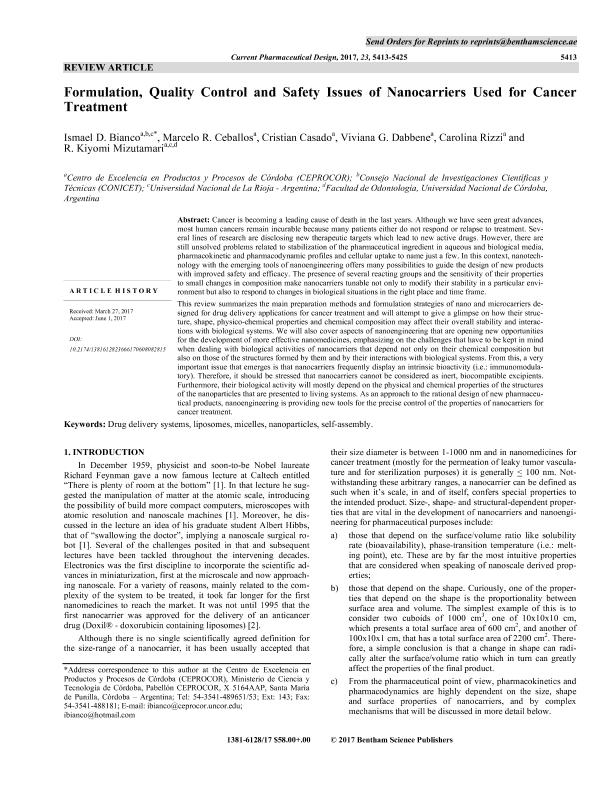Mostrar el registro sencillo del ítem
dc.contributor.author
Bianco, Ismael Dario

dc.contributor.author
Ceballos, Marcelo Ramon

dc.contributor.author
Casado, Cristian
dc.contributor.author
Dabbene, Viviana G.
dc.contributor.author
Rizzi, Carolina
dc.contributor.author
Mizutamari, Roxana Kiyomi

dc.date.available
2019-05-24T15:34:59Z
dc.date.issued
2017-10
dc.identifier.citation
Bianco, Ismael Dario; Ceballos, Marcelo Ramon; Casado, Cristian; Dabbene, Viviana G.; Rizzi, Carolina; et al.; Formulation, quality control and safety issues of nanocarriers used for cancer treatment; Bentham Science Publishers; Current Pharmaceutical Design; 23; 35; 10-2017; 5413-5425
dc.identifier.issn
1381-6128
dc.identifier.uri
http://hdl.handle.net/11336/77042
dc.description.abstract
Cancer is becoming a leading cause of death in the last years. Although we have seen great advances, most human cancers remain incurable because many patients either do not respond or relapse to treatment. Several lines of research are disclosing new therapeutic targets which lead to new active drugs. However, there are still unsolved problems related to stabilization of the pharmaceutical ingredient in aqueous and biological media, pharmacokinetic and pharmacodynamic profiles and cellular uptake to name just a few. In this context, nanotechnology with the emerging tools of nanoengineering offers many possibilities to guide the design of new products with improved safety and efficacy. The presence of several reacting groups and the sensitivity of their properties to small changes in composition make nanocarriers tunable not only to modify their stability in a particular environment but also to respond to changes in biological situations in the right place and time frame. This review summarizes the main preparation methods and formulation strategies of nano and microcarriers designed for drug delivery applications for cancer treatment and will attempt to give a glimpse on how their structure, shape, physico-chemical properties and chemical composition may affect their overall stability and interactions with biological systems. We will also cover aspects of nanoengineering that are opening new opportunities for the development of more effective nanomedicines, emphasizing on the challenges that have to be kept in mind when dealing with biological activities of nanocarriers that depend not only on their chemical composition but also on those of the structures formed by them and by their interactions with biological systems. From this, a very important issue that emerges is that nanocarriers frequently display an intrinsic bioactivity (i.e.: immunomodula-tory). Therefore, it should be stressed that nanocarriers cannot be considered as inert, biocompatible excipients. Furthermore, their biological activity will mostly depend on the physical and chemical properties of the structures of the nanoparticles that are presented to living systems. As an approach to the rational design of new pharmaceutical products, nanoengineering is providing new tools for the precise control of the properties of nanocarriers for cancer treatment.
dc.format
application/pdf
dc.language.iso
eng
dc.publisher
Bentham Science Publishers

dc.rights
info:eu-repo/semantics/openAccess
dc.rights.uri
https://creativecommons.org/licenses/by-nc-sa/2.5/ar/
dc.subject
Drug Delivery Systems
dc.subject
Liposomes
dc.subject
Micelles
dc.subject
Nanoparticles
dc.subject
Self-Assembly
dc.subject.classification
Nano-materiales

dc.subject.classification
Nanotecnología

dc.subject.classification
INGENIERÍAS Y TECNOLOGÍAS

dc.title
Formulation, quality control and safety issues of nanocarriers used for cancer treatment
dc.type
info:eu-repo/semantics/article
dc.type
info:ar-repo/semantics/artículo
dc.type
info:eu-repo/semantics/publishedVersion
dc.date.updated
2019-05-23T14:47:50Z
dc.identifier.eissn
1873-4286
dc.journal.volume
23
dc.journal.number
35
dc.journal.pagination
5413-5425
dc.journal.pais
Estados Unidos

dc.journal.ciudad
Oak Park
dc.description.fil
Fil: Bianco, Ismael Dario. Provincia de Córdoba. Ministerio de Ciencia y Técnica. Centro de Excelencia en Productos y Procesos de Córdoba; Argentina. Universidad Nacional de La Rioja; Argentina. Consejo Nacional de Investigaciones Científicas y Técnicas. Centro Científico Tecnológico Conicet - Córdoba; Argentina
dc.description.fil
Fil: Ceballos, Marcelo Ramon. Provincia de Córdoba. Ministerio de Ciencia y Técnica. Centro de Excelencia en Productos y Procesos de Córdoba; Argentina
dc.description.fil
Fil: Casado, Cristian. Provincia de Córdoba. Ministerio de Ciencia y Técnica. Centro de Excelencia en Productos y Procesos de Córdoba; Argentina
dc.description.fil
Fil: Dabbene, Viviana G.. Provincia de Córdoba. Ministerio de Ciencia y Técnica. Centro de Excelencia en Productos y Procesos de Córdoba; Argentina
dc.description.fil
Fil: Rizzi, Carolina. Provincia de Córdoba. Ministerio de Ciencia y Técnica. Centro de Excelencia en Productos y Procesos de Córdoba; Argentina
dc.description.fil
Fil: Mizutamari, Roxana Kiyomi. Provincia de Córdoba. Ministerio de Ciencia y Técnica. Centro de Excelencia en Productos y Procesos de Córdoba; Argentina
dc.journal.title
Current Pharmaceutical Design

dc.relation.alternativeid
info:eu-repo/semantics/altIdentifier/url/http://www.eurekaselect.com/153001/article
dc.relation.alternativeid
info:eu-repo/semantics/altIdentifier/doi/http://dx.doi.org/10.2174/1381612823666170608082815
Archivos asociados
